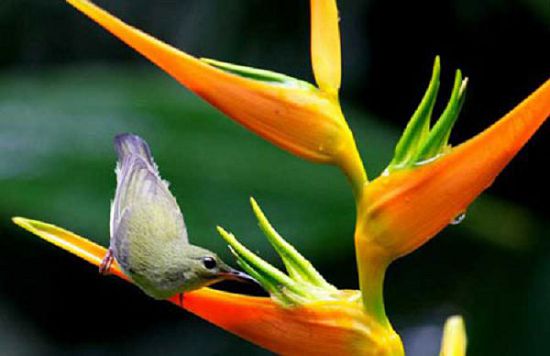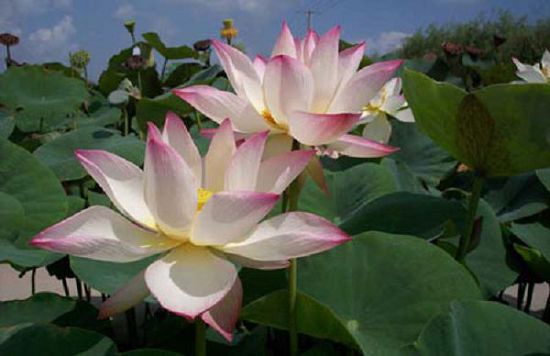Breeding methods and pest control knowledge of potted flowers and birds of paradise

The growth habits of Paradise Flowers
Bird of Paradise is native to southern Africa, is a subtropical long sunshine plant, like warm, humid, sunny environment, fear of cold, avoid extreme heat, avoid drought, avoid waterlogging, require good drainage of loose, fertile, pH 6: 7 sandy loam soil, the optimum temperature for the growing season is 20: 28 ℃, cultivated in parks and flower beds in big cities in the south of China, and cultivated in greenhouses in the north.
Breeding methods of Paradise Bird Flower
1. Sowing: under general cultivation conditions, birds of paradise flowers must be artificially pollinated in order to bear seeds. Before sowing, select seeds that are large and full, smooth seed coat, fresh, harmless, disease-free and pest-free. Soak the seeds in 30-40 ℃ warm water for 4-5 days, then disinfect them with 5% bromogeramine 1000 times solution for 5 minutes. Sowing time from May to July, using on-demand, covering soil 1-1.5 cm, covered with plastic film after watering, heat preservation and moisturizing. The suitable temperature for germination is 25: 30 ℃, and can be germinated 15-20 days after sowing, and then unearthed one after another.
2. Ramet: the ramet propagation of Paradise bird flower is carried out during the combination of pot change and soil change in early spring from February to March. Pour the plant out of the flowerpot, gently remove the old soil from the periphery of the soil block, do not break the fleshy root, hang it in the shade for 1 to 2 days, and wait for the root system to soften, then use a sharp knife to cut off the surrounding tiller seedlings with roots from the root gap, so that the small clump has 2 or 3 buds, each with 2 or 3 succulent roots. Apply plant ash to the cut, dry it to form a protective layer, and then replant it in wooden buckets, ceramic jars, or white plastic pots.
Culture methods of Paradise Birds and Flowers
1. Potted soil: the bird flower of paradise has thick fleshy roots, so it can be mixed with 5 parts of rotten leaf soil or peat soil, 3 parts of garden soil, 1 part of rotten stable fertilizer soil and 1 part of coarse sand. If the permeability of the cultivated soil is poor, coupled with too much watering, it is very easy to cause rotten roots. Its root system is developed and grows fast, so it is necessary to change the basin in time.
2. Temperature: birds of Paradise prefer warm, humid and semi-shady environment, the suitable temperature is 12 ℃ to 25 ℃, and the room temperature should be kept above 5 ℃ in winter. Suitable for the growth of loose and deep humus soil. Natural florescence is autumn and winter, such as temperature, light, fertilizer and water are suitable, the four seasons can blossom, each flower can bloom for more than a month.
3. Watering: bird of Paradise flowers should be watered dry and wet, adequate watering in summer, and often spray water on the leaves and the ground around flowerpots in spring and summer, so as to improve air humidity and create a cool environment, which is beneficial to its growth and development. Watering should be reduced after late autumn, and watering should be controlled in winter to keep the basin soil dry.
4. Fertilization: bird of Paradise flowers are required to apply thin fertilizer water every semimonthly during the growing period. It is best for family farming to irrigate fermented rice panning water or soy bean soaking solution, and 0.5% calcium superphosphate can be added to the fertilizer solution from the formation of flowering stems to the full flowering period. this will make the flowers more colorful.
5. Lighting: bird flowers in paradise should have no less than 4 hours of direct light every day, preferably with bright light all day, and take some protective measures when the sun is strong. In the main flowering period in winter, sufficient sunshine is beneficial to increase flower yield. Light regulation emphasizes the management principle of not overcast in winter and no sun in summer. The leaves of the plant will look more beautiful in the shade, but the number of flowers will be less.
Disease and pest control of birds and flowers in paradise
1. Anthracnose: harmful leaves and stems, the disease spot is round, the edge is surrounded by a reddish-brown line, and the central brownish gray is spread flat. When the conditions are right, the conidia are spread by water sputtering and invade from the wound, and the disease is easy to occur when the humidity is high. It is found that the diseased leaves are cut out along the edge, and the diseased leaves can also be removed, burned or buried deeply. Spray 25% carbon tetralin wettable powder 500 times or 40% polysulfide glue suspension.
2. Root rot: when root rot is found, it is necessary to disinfect the soil and control watering, remove the rotten roots, and spread quicklime in the soil or disinfect the soil with 70% pentachloronitrobenzene. At the initial stage of the disease, 50% Likujing wettable powder 1000 times solution or 50% carbendazim wettable powder solution and 70% methyl topiramate wettable powder solution were sprayed alternately or irrigated the roots, once every 10 days.
3. Wilt disease: the vascular bundles of the injured plants are infected, and the symptoms do not show until the adult plant stage. At the initial stage, the leaves showed dehydration or yellow patches or reticulated discoloration spots, and the leaves of seriously diseased plants fell off one after another, and finally the whole plant withered. The diseased body was removed and burned centrally. at the initial stage of the disease, 72% agricultural streptomycin soluble powder 4000 times or neophytomycin 4000 times solution was sprayed, once in 10 days, and used continuously for 3 times.
4. Spot blight: the diseased plants were cleared in time, burned centrally, the diseased leaves were cut off, and the wound or cut was smeared with 30% alkaline copper sulfate suspension. At the initial stage of the disease, the leaf surface was sprayed with 30% basic copper sulfate suspension 400 times or 70% Dysen zinc wettable powder 500 times every 10 days for 3 times.
5. Botrytis cinerea: during the onset of the disease, spray control with a 500x solution of 80% dimethane wettable powder or a 500x solution of 75% chlorothalonil, a 500x800-fold solution of thiophanate, a 1000-fold solution of 50% carbendazim, a 1500-fold solution of 50% propofol wettable powder and a 500x solution of 60% carbendazim wettable powder.
6. Greenhouse whitefly: take advantage of the strong tendency of greenhouse whitefly to yellow, trap it with sticky oil on the yellow plate, or spray it with 1000 times omethoate EC. As the insect body is on the back of the leaf, pay attention to fully spraying the back of the leaf when spraying.
7. Cinnabar spider mite: the injured leaves show small yellow-white spots at first, and when serious, the leaves curl, wither yellow and fall off, affecting growth or not flowering, adult mites are 0.5-0.6 mm long, female mites are oval, scarlet to embroidered red, or dark brown. The male mites are slightly rhomboid, yellowish and slightly smaller. Like to live in groups to feed on the back of leaves, the disease is easy to break out in high temperature and dry season. Use 20% diclofenac EC 800x, or 73% propargite 2000 times.
8. White shield scale: adults and nymphs are fixed on stems and leaves to suck leaf juice, resulting in leaves turning green, showing yellow spots, branches and leaves blackening, causing early shedding and even death. Cut off and burn the insect leaves, or scrape off the insect bodies on the leaves with a knife. The newly hatched larvae were controlled with 1000 times of dimethoate emulsion. The high temperature in summer is the active period of insect, which can be controlled by 2000 times of imidacloprid powder.
Related
- What if the leaves of potted flowers turn yellow?
- Florescence Control of several Flowers
- Anti-freezing technology and post-freezing nursing technology of flowers
- What is the classification of flowers? What are the common methods of flower classification?
- Prevention and control of alkali and acid damage of flowers in courtyard
- Technology of Anti-freezing and restoring growth of Flower seedlings in greenhouse and greenhouse
- How does flower fertilization not hurt the root? Fertilization technology of flowers
- Key points of disinfection in flower greenhouse
- Several pesticides that are banned or used cautiously in flowers
- How to fertilize the flowers that watch the leaves?



